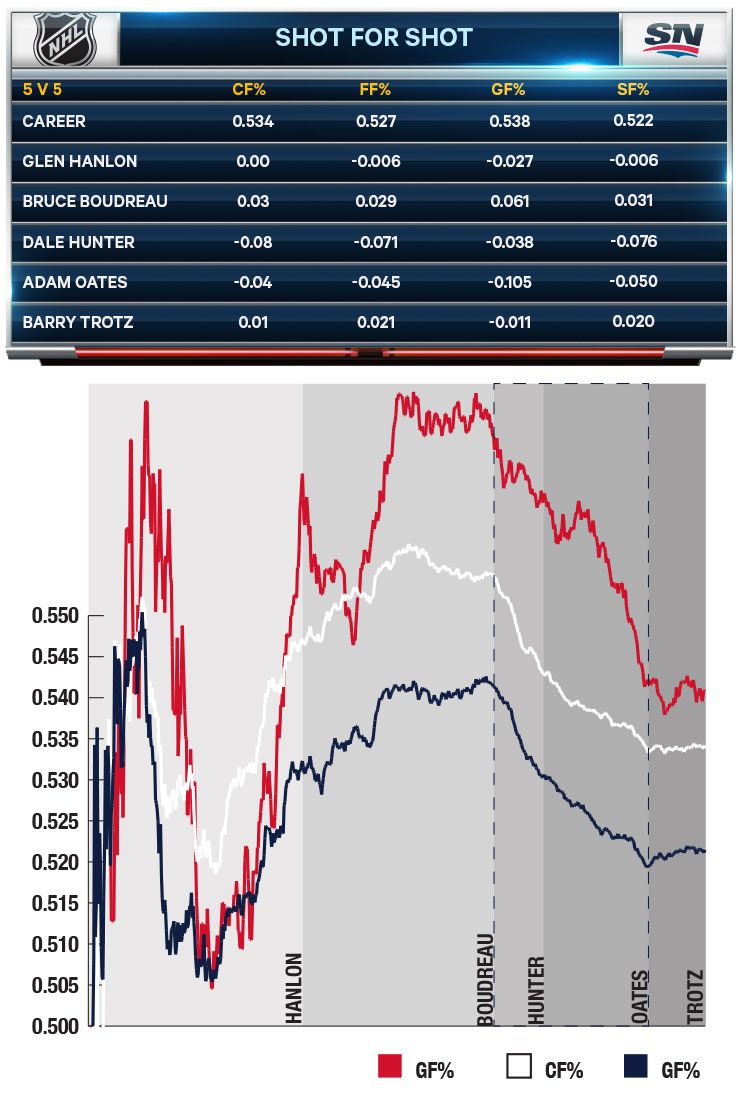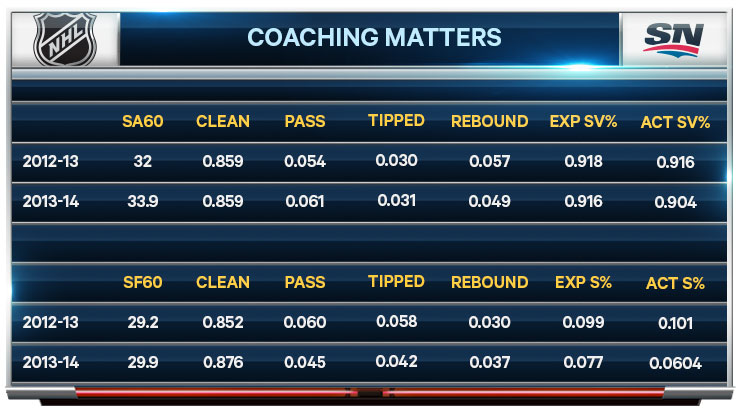Alex Ovechkin’s even-strength play has always been a target of criticism. Whether it is his perceived defensive indifference (this gif obviously doesn’t help his cause) or last season’s infamous minus-35, Ovechkin has always struggled with the “poor defender” label.
When the Capitals fail to win in the post-season, the conversation generally moves to Ovechkin. And since he’s been essentially the same offensive player in the playoffs as in the regular season, the easiest attack points become his character and again his lack of defensive commitment.
As advanced analytics attempt to combat this surface analysis, the same old trope is continually beaten to death: Hockey is a complex game and there isn’t a single stat—like baseball’s WAR—to simplify and ascertain a player’s effectiveness. But that’s precisely why a simplistic stat like plus-minus became a go-to for the lazy, even though it lacks context and can be influenced by uncontrollable factors like coaching tactics.
When Ovechkin was in the middle of his horrific 2013–14 season he was hammered for his minus-35, but the criticism totally ignored the environment in which it was produced. At no point did anybody place any of the blame on Adam Oates. Never mind that prior to Dale Hunter, Ovechkin had been plus-88 for his career. When Hunter was hired, the story became how his tough approach was forcing Ovechkin to block shots and was transforming him into a more defensively responsible player, even though none of the stats confirmed this.
Hunter did start Ovechkin in the offensive zone less, which impacted his numbers, but while doing so he managed to nullify one of the greatest offensive players in history. Oates replaced Hunter and reinvigorated Ovechkin’s power-play production, but even with favourable zone matchups his 5v5 play continued to collapse.

We’ve recently seen in Toronto how a new coach and a change in tactics can affect individual possession results. And with Barry Trotz replacing Oates, Ovechkin has returned to being an even-strength force.
Plus/minus also has a significant blind spot because it can be influenced by dominant or poor goaltending as well as percentage-driven results. I reviewed Ovechkin’s even-strength play (5v5 and 4v4) and attempted to figure out what his results would be if he received league-average shooting and goaltending.
(Note: When I see massive year-over-year contrasts in results, I check them vs. my research to see if I can clarify the conditions and the environment in which they were recorded. I don’t automatically put the blame on the goaltender—I want to check the context to understand the reason for the huge discrepancy.)
One of the most interesting things I noticed when dissecting Ovechkin’s performance under Oates was how percentage-driven both years were. The shot rates against were almost identical.

During Oates’s first season, the Capitals’ goaltending and shooting aligned with their expected result. This resulted in the expected +/- matching up with the actual result of +3.
The 2013–14 season was an extreme contrast. Defensively the Caps’ shot rate against got worse, but their expected save percentage remained consistent. The issue was the collapse of the Capitals’ goaltending. The backup-level netminding resulted in eight more goals against than expected while Ovechkin was on the ice. Offensively Ovechkin and his linemates produced lower-quality opportunities and cashed in fewer than the season before. This led to another 10 offensive goals that went unconverted.
Even removing these percentage-driven results, the Capitals under Oates still had a negative differential with Ovechkin on the ice at even strength. Instead of a 12-goal drop-off between seasons and a -9, the result was a disastrous 30-goal differential and a -27.
With the hiring of Trotz, Ovechkin’s offensive percentages returned to normal.

Under Trotz we can see the improvement. Ovechkin is relying less on clean looks to beat goaltenders and his line is employing more pre-shot movement
Defensively his line is suppressing shots and when those shots are registered, they are lower quality. Almost 90 percent of the shots are of the clean variety and they have cut the rebound opportunities by more than half. For the first time in three seasons his expected on-ice save percentage moved past the league average of .922 to .923. Unfortunately the Capitals’ goaltending again has underperformed.
Although backed by sub-par goaltending again, their improved play has avoided the disastrous negative goal differential of the previous two seasons when they became overly reliant on percentage-driven success.
Trotz walked into a great situation where everybody believed that Ovechkin was broken and needed to be fixed. In the end, that was far from true. All Ovechkin needed was an environment in which he could succeed.

